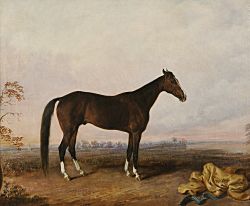Remembering the great Dexter
May 9, 2008,by Ken Weingartner, Harness Racing Communications
Freehold, NJ — The Dexter Cup is an annual tribute to the great trotter Dexter, who dominated harness racing in the mid-to-late 1860s and twice lowered the world record in 1867. This year’s Dexter Cup, the first major stakes event on the way to the Hambletonian, is Saturday afternoon, May 10, at Freehold Raceway.
But for one small town in southeastern Kansas, every day is a tribute to Dexter. After all, it was named in his honor.
According to a 1976 book titled Dexter Scrap Book, planning for the town’s creation came at the same time Dexter was at the height of his celebrity. It seems Dexter and trainer-driver Budd Doble passed through the area in 1866, and the locals were so enamored with the horse they decided his name would be fitting for their new town, which is 70 miles south of Wichita and just north of the Oklahoma border.
Details of the visit do not exist, nor an explanation why Dexter was in that area of Kansas. According to The Horse Review Portfolio: Part III, Trotting Champions, Doble, who took over the conditioning of Dexter in July 1866, and Dexter made a tour of the west in 1866. That year, Dexter won 25 of 26 starts.
Today, the town of Dexter is home to 360 residents. The small community achieved renown in 1903 with the discovery there of naturally occurring helium. It also is home to Henry’s Candies, which for years produced the “Oh Henry” candy bar.

photo courtesy of the Harness Racing Museum
Dexter was a superstar in the sport of harness racing 140 years ago.
Dexter, the horse, was born in 1858 in Orange County, New York, about 75 miles north of New York City. He was “wild as a hawk and always coming to grief,” as a youngster, according to The Horse Review. But his speed was so great and trotting action so perfect that he was sold for $400 as an unbroken 4-year-old to George B. Alley of New York.
Given to Hiram Woodruff (“That prince of drivers and trainers,” according to the New York Times) to train and drive, Dexter made his debut as a racehorse on May 4, 1864 at the Fashion Course on Long Island and won in straight heats.
In 1865, Dexter lost only once, to Lady Thorn in a match. In 1866, he won 25 of 26 starts. The next year, he beat the great Goldsmith Maid and then won five successive races against Lady Thorn.
Budd Doble took over the training and driving of Dexter in July 1866 (Woodruff probably was ill; he died in March 1867).
On July 30, 1867, Dexter won in 2:19, thereby setting the world record, which was previously 2:19-3/4 set by Flora Temple in 1859. Two weeks later, he trotted 2:17-1/4 in Buffalo to further lower the record. After three more wins, he retired.
The record set in Buffalo was held in particularly high regard because the course was considered “slow.” Only one other horse that week trotted a heat as fast as 2:30, according to Charles J. Foster, the editor of The Trotting-Horse of America, With Reminiscences of the Trotting Turf, copyrighted 1869.
Foster wrote, “The great fact which had so often been insisted upon by the admirers of Dexter was now being made manifest to the dullest mind; viz, that his deep bottom, and immense constitutional power of standing fast work, enabled him to improve under a course of traveling and racing which would’ve upset, and for the time ruined, any other trotter in existence.”
Dexter was purchased in September 1867 by Robert Bonner for $35,000 and was Mr. Bonner’s favorite road horse. In 1868, pulling 319 pounds of wagon and driver, Dexter trotted a mile in 2:21-3/4, according to the New York Times.
Dexter died April 21, 1888, but his name lives on — in racing and beyond.
